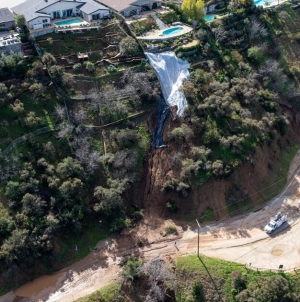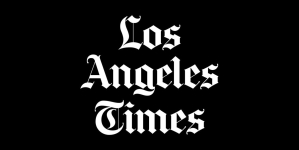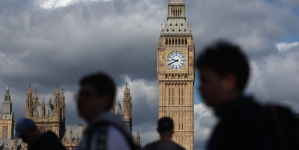-
Why Fears of a Broader Middle East Conflict Are Growing in Iraq - December 9, 2023
-
A portion of Mulholland Drive, damaged by mudslides in winter storms, reopens - May 26, 2024
-
‘Maybe You Don’t Want to Win’ - May 26, 2024
-
Donald Trump Putting Law Enforcement in Danger: Attorney - May 25, 2024
-
Avoid the waters of these 5 L.A. County beaches this holiday weekend, public health officials say - May 25, 2024
-
Bawdy Comedy ‘Anora’ Wins Palme d’Or at Cannes Film Festival - May 25, 2024
-
Map Shows Heat Wave Zone Spread Into Five New States - May 25, 2024
-
Azusa police arrest suspected slingshot-wielding vandal - May 25, 2024
-
Donald Trump Hammers Judge Ahead of Jury Instructions - May 25, 2024
-
Sometimes U.S. and U.K. Politics Seem in Lock Step. Not This Year. - May 25, 2024
Why Fears of a Broader Middle East Conflict Are Growing in Iraq
Just south of Baghdad, the urban sprawl gives way to glimpses of green, with lush date palm groves bordering the Euphrates River. But few risk spending much time there. Not even the Iraqi military or government officials venture without permission.
A farmer, Ali Hussein, who once lived on that land, said, “We do not dare to even ask if we can go there.”
That’s because this stretch of Iraq — more than twice the size of San Francisco — is controlled by an Iraqi militia linked to Iran and designated a terrorist group by the United States. Militia members man checkpoints around the borders. And though sovereign Iraqi territory, the area, known as Jurf al-Nasr, functions as a “forward operating base for Iran,” according to one of the dozens of Western and Iraqi intelligence and military officers, diplomats and others interviewed for this article.
The militia that controls the land, Khataib Hezbollah, uses it to assemble drones and retrofit rockets, with parts largely obtained from Iran, senior military and intelligence officials say. Those weapons have then been distributed for use in attacks by Iranian-linked groups across the Middle East — putting this former farmland at the center of fears that the war in Gaza could grow into a wider conflict.
Such attacks have increased sharply over the past two months as Khataib Hezbollah and other groups linked to Iran have rallied to show their solidarity with Palestinians. Since Oct. 17, Iraqi groups have launched at least 82 drone and rocket attacks against U.S. military installations just in Iraq and Syria, wounding 66 service members, according to the Pentagon. Many of the attacks used weapons from Jurf al-Nasr, regional intelligence sources say.
Responding to the recent attacks, the United States bombed two locations in Jurf al-Nasr, killing at least eight members of Khataib Hezbollah, according to the Pentagon as well as the militant group.
“They have rockets, mortars, missiles,” said Gen. Kenneth F. McKenzie Jr., who retired last year as the head of U.S. Central Command, which oversees American forces in the region. He said he did not know the exact ranges that the weapons might have now, but that in 2020 — when he oversaw the last U.S. effort to reduce the arsenal — some could reach targets in Jordan, Syria and Saudi Arabia.
For decades, Iran’s Middle East strategy has been to meld informal military power through local armed groups with political influence over government policies. Starting in the 1980s, it helped finance and arm Lebanese Hezbollah. Then it gave expansive military and political support to the Syrian regime of Bashar al-Assad; military aid to the Houthis in northern Yemen; and support for the Al Ashtar Brigades in Bahrain.
But Iraq is Iran’s most natural regional partner, even if the countries once fought a long war against each other.
They share a 1,000-mile border; many families have relatives on both sides; and economic ties are strong. Also, Iraq, like Iran, has a Shiite Muslim majority, and it is home to some of the most important Shiite shrines.
After Iraq’s 2021 elections, Iranian-linked political parties, most with militia wings, claimed for the first time a large enough share of parliamentary seats to form a governing coalition and select the prime minister, Mohammed Shia al-Sudani. This tied him politically to parties whose priorities are often shaped as much by Tehran’s concerns as by Baghdad’s.
For the United States, Tehran’s political gains in Baghdad, and the commandeering of Jurf al-Nasr by a militia allied with Tehran, are a startling reversal of fortune.
Over the past 20 years, Republican and Democrat governments alike invested $1.79 trillion in overthrowing Saddam Hussein, battling Al Qaeda and joining Iraq’s fight against the Islamic State, all with the aim of creating stability and a reliable ally.
Instead, Iran, more than ever, is “the predominant influence in Iraq today,” said Hoshyar Zebari, who was Iraq’s foreign minister for 10 years and finance minister until 2016.
Iran’s interests, he said, affect “every sector of the security forces, the military, the provincial governors.”
How a Militia Took Control
Since the rise of Iran’s theocratic regime in 1979, it has wanted to force the U.S. military out of the Middle East. Sajad Jiyad, an Iraq analyst and nonresident fellow at Century International, a research group, said that when President George W. Bush described Iran as part of an “Axis of Evil,” it sounded as if Washington was saying, “You’re next — Iraq, Iran, North Korea, we’re coming for you.”
So Iran focused on creating, training and arming Iraqi Shiite militias to attack American forces on Iraqi soil. The U.S. military said that between just 2003 and 2011, Iranian-backed groups were responsible for the deaths of 603 U.S. troops in Iraq.
One of those groups was Khataib Hezbollah, which from its inception was closely tied to Iran’s Qud’s Force, the wing of Iran’s Islamic Revolutionary Guards Corps responsible for proxy militias around the region.
In 2011, the American military withdrew from Iraq, and in 2014, the Islamic State invaded. The Iraqi Army collapsed and the government in Baghdad asked its friends — Iran and the United States — for help.
Iran responded quickly, sending trainers and weapons and helping recruit a volunteer Iraqi force — eventually known as Popular Mobilization Units — to fight the ISIS invaders alongside Iranian-linked militias, including Khataib Hezbollah. The United States sent help, too, but several weeks later.
Part of the battle took place in Jurf al-Nasr, then known as Jurf al-Sakhar, an Islamic State staging ground for attacks on nearby Shiite villages and on pilgrims, millions of them Iranians, who traveled through the area on their way to Shiite shrines in Karbala and Najaf.
“Iran always made protection of those shrines a priority,” said Kareem al-Nuri, then a commander in the Badr Corps, another Iranian-linked armed group.
Jurf al-Nasr was also strategically located, with roads that led west to Syria, a route to ferry weapons to Iranian-backed Lebanese Hezbollah.
During the fighting, Khataib Hezbollah emptied every Sunni village, telling people they would be able to return once the Islamic State was gone. Human Rights Watch and Amnesty International documented hundreds of disappearances, primarily of Sunni men, in the area; the 2019 U.S. State Department’s Human Rights Report said 1,700 people were held in a secret prison there.
When the fighting was done, Jurf al-Nasr remained under the control of Khataib Hezbollah.
In 2016, Khataib Hezbollah and other Iranian-linked militias, along with the Popular Mobilization Units, became part of the Iraqi security apparatus, with the Iraq treasury paying salaries for fighters and providing weapons — including for units that have continued to attack U.S. forces.
This year, Iraq’s prime minister, Mr. Sudani, approved a three-year budget with more money for the fighters, who now number more than 150,000, to grow by at least 20 percent — “a major expansion,” according to Michael Knights, a fellow at the Washington Institute for Near East Policy, who follows Iraq’s armed forces and their ties to Iran.
Iran denies that it controls the armed Iraqi groups that have attacked U.S. forces, but in a recent interview, its foreign minister, Hossein Amir-Abdollahian, said he viewed the United States as complicit in Israel’s war in Gaza, adding that the militias were created to fight terrorism and occupation.
Experts say the Iraqi militias with the closest ties to Iran — like Khataib Hezbollah — have “a shared ideological vision “ with Tehran, as Inna Rudolf, a senior fellow at the International Center for the Study of Radicalization in London, put it. That vision largely accepts Iran’s theocratic philosophy of governance and the broader goals of forcing U.S. troops out of Iraq and destroying the state of Israel.
‘We Don’t Ask About These Things’
Today, a reporter visiting near Jurf al-Nasr cannot miss the overwhelming signs of Khataib Hezbollah’s presence.
The checkpoints on the roads into the area fly the group’s flag — white with a sketch of a fist gripping a stylized Kalashnikov rising out of a globe, and the words “Party of God” in Arabic calligraphy. The central street in the nearby town of Mussayib, outside the checkpoints, is lined with “martyrs flags” imprinted with photos of militia men who lost their lives fighting in Iraq, and with large posters depicting Iran’s celebrated Quds Force leader, Gen. Qassim Suleimani, who was assassinated by the United States in 2020.
In interviews in Mussayib and other villages, residents — who refused to give their names — said that they didn’t know what was happening in Jurf al-Nasr but that the only people who traveled through the checkpoints were Khataib Hezbollah operatives and foreigners speaking Arabic with an Iranian or Lebanese accent.
Western and Iraqi diplomats and intelligence officers, however, paint a picture of what goes on there, just 40 miles south of Baghdad.
They say Iranian Revolutionary Guards and Lebanese Hezbollah trainers teach drone assembly and how to retrofit precision guidance systems onto rockets and surface-to-air missiles. For the rockets, General McKenzie said, “upgraded components will come from Iran.”
Khataib Hezbollah’s rocket arsenal is mostly composed of shorter-range conventional Katyusha rockets, but also includes some longer range ones, said former and present intelligence and military officials, including General McKenzie, and Khataib Hezbollah commanders.
Some weapons are shipped into Syria, according to Western and Middle Eastern military and intelligence reports. From there, they can be transported to Russia or Lebanon, said an intelligence official in the region.
It is unclear, several people interviewed said, whether the longer-range rockets are entirely under the control of the Iraqi armed groups or if Iranian Revolutionary Guards supervise closely the use of the most sophisticated weapons.
The former farmland also includes storage facilities for weapons, with smaller quantities stored elsewhere in Iraq, according to Western and Iraqi security officials, as well as people close to Khataib Hezbollah.
Israel has long worried about Khataib Hezbollah’s growing weapons stockpiles. In 2019 Israeli warplanes hit a large arms depot in Baghdad in an area partly controlled by Khataib Hezbollah. In both 2019 and 2022, Israel struck Khataib Hezbollah camps in Syria, just over the Iraqi border. It has never hit Jurf al-Nasr.
In an interview in September, Prime Minister al-Sudani did not respond to questions about military activities in Jurf al-Nasr. In October, he publicly condemned the attacks on U.S. bases and camps, but his words have had little effect. In the September interview, though, he said he hoped that families displaced from Jurf al-Nasr could go back home.
For those families, returning seems a receding dream.
“We have not heard anything about what happened to our lands, to our homes,” said Abu Arkan, 70, who was displaced in 2014.
Then he waved a reporter away.
“I do not want to talk about this subject any longer because it depresses me,” he said. “Nobody comes to us to bring us back. No one compensates us for what we have lost. We are like ghosts.”
Reporting was contributed by Eric Schmitt from Washington, Farnaz Fassihi from New York, Falih Hassan from Baghdad, and Kamil Kakol from Erbil, Iraq.































